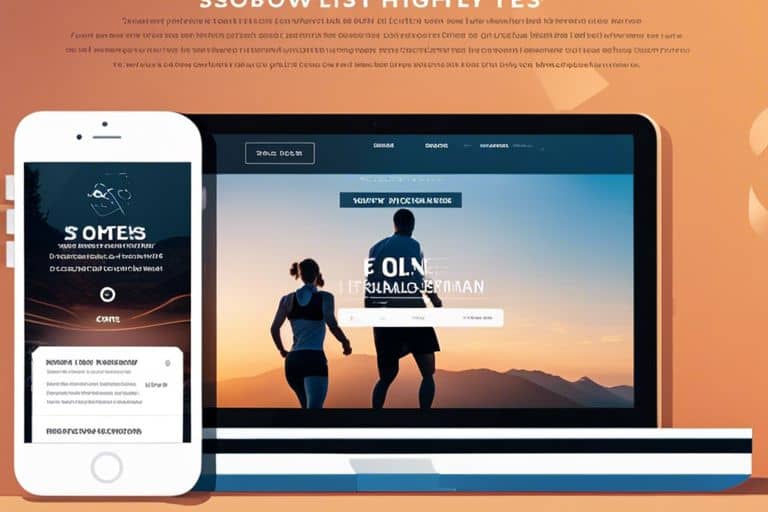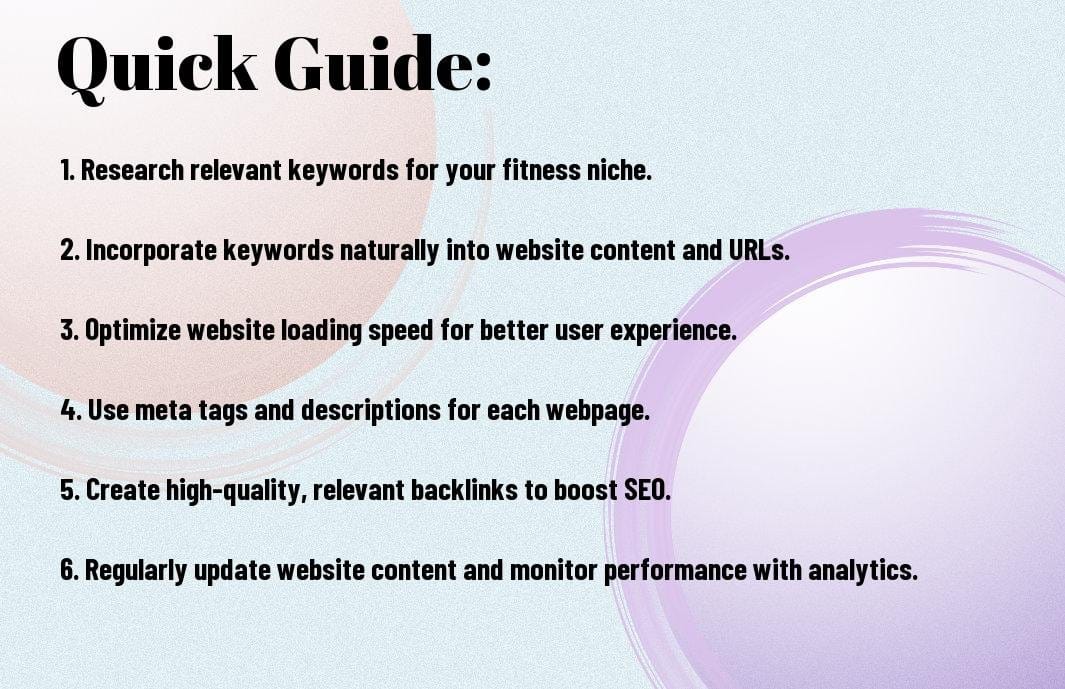Optimizing Your Personal Training Website For Search Engines – A Beginner's Guide
yeswebsite
14 Feb, 2024

Search Engines are a crucial gateway for potential clients to discover your personal training website. To ensure your website ranks high in search results and attracts more traffic, optimizing it for search engines is vital. This beginner’s guide will walk you through key strategies and techniques to improve your website’s visibility and increase its chances of being found by those searching for personal training services online.
Key Takeaways:
- Keyword research: Conduct thorough research to identify relevant keywords for your personal training website to optimize your content for search engines.
- On-page optimization: Optimize your website’s title tags, meta descriptions, headings, and images with targeted keywords to improve search engine visibility.
- Quality content: Create high-quality, valuable content that appeals to your target audience and incorporate relevant keywords naturally throughout your website to enhance SEO performance.

Understanding SEO
Obviously, understanding Search Engine Optimization (SEO) is crucial for optimizing your personal training website for search engines. If you’re new to SEO, I recommend checking out 5 SEO Tips for Personal Trainers to get started on the right foot.
What is Search Engine Optimization?
Any personal training website can benefit from SEO, which is the practice of optimizing your site to rank higher in search engine results pages (SERPs). By improving your website’s visibility, you increase the chances of attracting more potential clients.
SEO involves a variety of strategies and techniques, including keyword research, on-page optimization, link building, and content creation. The goal is to make your website more relevant and authoritative in the eyes of search engines like Google, ultimately driving more organic traffic to your site.
Key Factors Impacting SEO
Any personal trainer looking to boost their website’s SEO should pay attention to key factors that influence search engine rankings. These factors include:
- Keyword optimization
- Quality of content
- Backlink profile
- Website speed and performance
This comprehensive approach to SEO will help improve your website’s visibility and ultimately attract more potential clients. Understanding how these factors work together is necessary for achieving success in the competitive online landscape.
Types of SEO Practices
All websites need to implement various types of SEO practices to improve their search engine rankings and attract more organic traffic. There are primarily three types of SEO practices: On-Page Optimization, Off-Page Optimization, and Technical SEO. Each of these practices plays a crucial role in optimizing your personal training website for search engines.
| On-Page Optimization | Off-Page Optimization |
| Keyword research and optimization | Building high-quality backlinks |
| Optimizing meta tags and headings | Social media marketing |
| Creating high-quality content | Guest blogging |
| Improving website speed and user experience | Online reputation management |
| Optimizing images and multimedia | Influencer partnerships |
Any successful SEO strategy will incorporate a combination of these practices to achieve the best results for your personal training website. It’s vital to understand how each type of SEO practice works and how they can complement each other to enhance your website’s visibility and credibility in search engine results.
On-Page Optimization
An integral part of SEO, on-page optimization involves optimizing various elements on your website to improve its search engine visibility. This includes optimizing meta tags, headings, images, and content with relevant keywords. By focusing on on-page elements, you can enhance the user experience and make it easier for search engines to crawl and index your site effectively.
For a personal training website, on-page optimization can also involve creating landing pages for specific services, optimizing contact forms for lead generation, and improving website navigation for better user engagement and conversion rates.
Off-Page Optimization
For off-page optimization, the focus is on activities that take place outside of your website to improve its authority and relevance in the eyes of search engines. This includes building high-quality backlinks from reputable websites, engaging in social media marketing, and guest blogging on industry-related sites. Off-page optimization helps increase your website’s visibility and credibility, ultimately boosting its rankings in search engine results.
Types of off-page optimization activities also include influencer partnerships, online reputation management, and participating in industry forums and communities to establish your website as an authority in the personal training niche.
Technical SEO
Technical SEO involves optimizing the technical aspects of your website to improve its crawlability, indexation, and overall performance in search engine results. This includes optimizing website speed, implementing structured data markup, fixing broken links, and ensuring mobile-friendliness. By focusing on technical SEO, you can enhance the overall user experience and make it easier for search engines to understand and rank your website efficiently.
For instance, implementing HTTPS encryption, creating XML sitemaps, and optimizing robots.txt files are vital technical SEO practices that can have a significant impact on your website’s search engine rankings and visibility.
Step-by-Step SEO Optimization
Your personal training website can greatly benefit from search engine optimization (SEO) to increase visibility and attract more clients. This chapter will guide you through the process of optimizing your website for search engines in a step-by-step manner.
| Conducting Keyword Research | |
Any effective SEO strategy begins with thorough keyword research. Identify relevant keywords that potential clients may use to search for personal training services. Use tools like Google Keyword Planner, SEMrush, or Ahrefs to discover high-volume keywords with low competition. |
Once you have a list of target keywords, strategically incorporate them into your website’s content, meta tags, and headings. Focus on long-tail keywords that are specific to your services and location to attract quality traffic. |
Creating Quality Content
One of the most critical aspects of SEO is creating high-quality, relevant content for your personal training website. Content should be informative, engaging, and optimized for your target keywords. Regularly update your blog with articles, videos, and client testimonials to keep your audience engaged and boost your search engine rankings.
Research shows that websites with fresh, relevant content rank higher in search results. Make sure your content is unique, well-written, and provides value to your visitors. Incorporate your target keywords naturally within the content to improve visibility and drive organic traffic to your site.
Optimizing Website Structure
Importance of website structure cannot be overlooked in SEO optimization. Ensure your website is well-organized with clear navigation menus, internal linking, and a sitemap. A logical website structure helps search engines crawl and index your pages effectively, improving overall visibility.
Keyword placement in URLs, headings, and image alt text can also impact your website’s SEO performance. By structuring your website to include target keywords in these elements, you can enhance the relevance of your content and improve your chances of ranking higher in search results.
SEO Tips for Personal Trainers
Now that you have your personal training website up and running, it’s time to optimize it for search engines. Implementing SEO strategies can help improve your website’s visibility and reach potential clients more effectively. Here are some tips to help you get started:
- Focus on relevant keywords related to personal training such as “personal trainer”, “fitness coach”, or “online training”. Incorporate these keywords naturally throughout your website’s content.
- Optimize your website’s meta tags, including title tags, meta descriptions, and alt tags for images, with relevant keywords to improve your site’s search engine ranking.
- Make sure your website is mobile-friendly, as mobile optimization is crucial for SEO rankings.
- Create high-quality and engaging content on a regular basis to keep your website fresh and relevant to both users and search engines.
- Utilize local SEO strategies to target clients in your area and improve your chances of being found by people searching for personal trainers nearby.
Recall, search engine optimization is an ongoing process, so be patient and consistent with your efforts. Over time, you’ll start to see improvements in your website’s visibility and organic traffic from search engines. Though, never underestimate the power of SEO in growing your personal training business online.
Local SEO Strategies
On your personal training website, make sure to include your location and contact information prominently on every page. This will help search engines understand where you are based and connect you with local clients looking for personal trainers in your area. Additionally, create a Google My Business profile and list your business on local directories to improve your local SEO.
Implementing local SEO strategies can help boost your website’s ranking in local search results, making it easier for people in your community to find and contact you for personal training services. By focusing on local optimizations, you can stand out in a crowded market and attract clients who are actively seeking the services you offer.
Leveraging Social Media
One of the most effective ways to increase your online presence and reach a larger audience is by leveraging social media platforms such as Facebook, Instagram, and LinkedIn. Engaging with your followers, sharing valuable content, and promoting your services on social media can help drive traffic to your website and attract potential clients.
To maximize the impact of your social media efforts, create a content calendar to plan out your posts and ensure consistency. Use a mix of images, videos, and text posts to keep your audience engaged and interested in what you have to offer. By leveraging social media effectively, you can establish your brand, connect with clients, and expand your reach in the competitive personal training industry.
Technical Factors for SEO Success
Many factors contribute to the success of your personal training website in search engine rankings. Understanding and optimizing these technical aspects can significantly boost your site’s visibility to potential clients.
Site Speed and Performance
Factors such as site speed and performance play a crucial role in SEO ranking. Search engines like Google prioritize websites that load quickly and provide a seamless user experience. To improve your site’s speed, consider optimizing images, leveraging browser caching, and minimizing HTTP requests.
Additionally, mobile responsiveness is necessary for SEO success. With an increasing number of users browsing on mobile devices, a mobile-friendly website is key to ranking well in search results. Ensure that your site is responsive and provides a smooth user experience across all devices.
Secure Sockets Layer (SSL) and HTTPS
An SSL certificate and using HTTPS are vital for SEO success. Websites that are secure and encrypted with HTTPS are favored by search engines. Not only does it improve your site’s credibility and trustworthiness, but it also provides a secure connection for user data.
For instance, Google Chrome now displays a “Not Secure” warning for websites without an SSL certificate, which can deter visitors and impact your SEO rankings. Implementing SSL and HTTPS is a fundamental step towards optimizing your personal training website for search engines.
- Site Speed and Performance
- Mobile Responsiveness
- SSL Certificate and HTTPS Implementation
After optimizing these technical factors, your personal training website will be better positioned to rank higher in search engine results and attract more clients.
Pros and Cons of SEO for Personal Training Websites
After optimizing your personal training website for search engines, it’s crucial to understand the pros and cons that come with SEO strategies. A balanced view will help you make informed decisions on how to best approach improving your website’s visibility online. Let’s explore the advantages and challenges of SEO for personal training websites.
| Pros | Cons |
| Increased visibility and traffic | Time-consuming process |
| Builds credibility and trust | Constant algorithm updates |
| Cost-effective compared to paid advertising | Results may take time to show |
Advantages of Investing in SEO
Investing in SEO for your personal training website can significantly boost your online presence and attract more potential clients. By optimizing your site for relevant keywords and improving your search engine rankings, you can increase visibility and drive organic traffic to your website. To learn more about personal trainer SEO and how to rank #1 fast, check out Personal Trainer SEO [2023] Rank #1 FAST.
Furthermore, SEO helps you build credibility and trust with your audience. When your website appears on the first page of search engine results, users are more likely to perceive you as a reputable and reliable personal trainer. This can lead to higher conversion rates and more clients seeking your services.
Challenges and How to Overcome Them
Challenges associated with SEO for personal training websites include the time-consuming nature of the process and the need to stay updated with constant algorithm changes. However, by dedicating time and resources to SEO practices such as content optimization and link building, you can overcome these challenges and achieve long-term success in improving your website’s search engine rankings.
While results may not be immediate, consistent efforts in implementing SEO strategies can lead to sustainable growth and increased visibility in the competitive online landscape. By focusing on high-quality content, user experience, and technical optimization, you can overcome the challenges of SEO and reap the benefits of a well-optimized personal training website.
Maintaining SEO Rankings
Once again, congratulations on successfully optimizing your personal training website for search engines! However, the work doesn’t stop here. To ensure that your website continues to rank well in search engine results, you must focus on maintaining your SEO rankings over time.
Regular Content Updates
Rankings can be affected by the freshness of your content. Search engines like to see websites that are regularly updated with new and relevant content. By consistently adding new blog posts, articles, client testimonials, or workout videos, you not only provide value to your visitors but also signal to search engines that your website is active and worth indexing.
Furthermore, updating your content gives you the opportunity to target new keywords and address trending topics in the fitness industry. This can help you attract a wider audience and improve your website’s visibility in search results.
Monitoring SEO Performance
Rankings can fluctuate due to changes in search engine algorithms, new competitors entering the market, or technical issues on your website. It’s crucial to monitor your SEO performance regularly to identify any drops in rankings and take corrective actions promptly.
Any significant changes in your SEO performance should be investigated, and adjustments to your SEO strategy may be necessary. By staying vigilant and proactive in monitoring your website’s SEO performance, you can maintain and improve your rankings over time.
Final Words
To wrap up, optimizing your personal training website for search engines is a crucial step in attracting more clients and growing your business online. By following the beginner’s guide outlined in this article, you can improve your website’s visibility and increase its chances of ranking higher on search engine results pages. Remember to focus on relevant keywords, create quality content, and enhance user experience to drive traffic to your website.
Keep in mind that search engine optimization is an ongoing process, and it may take time to see significant results. Stay consistent with your efforts, monitor your website’s performance, and make necessary adjustments to better optimize for search engines. By implementing these strategies, you can set yourself up for success and stand out in the competitive personal training industry.
FAQ
Q: Why is it important to optimize a personal training website for search engines?
A: Optimizing your personal training website for search engines is important because it helps potential clients find your services online easily. By improving your website’s SEO, you can increase your visibility, attract more traffic, and ultimately grow your business.
Q: What are some key elements to consider when optimizing a personal training website for search engines?
A: Some key elements to consider when optimizing a personal training website for search engines include keyword research, on-page SEO, mobile optimization, quality content, and backlink building. These elements help improve your website’s ranking on search engine results pages.
Q: How can keyword research benefit the optimization of a personal training website?
A: Keyword research helps you identify the terms and phrases potential clients are using to search for personal training services online. By incorporating these keywords strategically into your website’s content, meta tags, and headings, you can improve your chances of ranking higher in search results.
Q: Why is creating quality content crucial for SEO optimization of a personal training website?
A: Quality content not only engages website visitors but also helps search engines understand the relevance and authority of your website. By creating informative and valuable content related to personal training, you can attract more visitors, earn backlinks, and improve your website’s SEO performance.
Q: How can social media marketing complement the SEO optimization of a personal training website?
A: Social media marketing can complement SEO optimization by driving traffic to your website, increasing brand awareness, and helping you engage with your audience. By sharing your quality content on social media platforms, you can attract more visitors, earn social signals, and ultimately improve your website’s search engine rankings.
Continue reading
Purely you






Leave a Reply